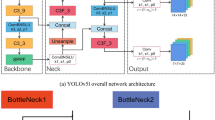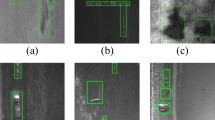Abstract
Aiming at the problem of a large number of parameters and large computation in deep learning for steel rolling defect detection, a lightweight object detection algorithm was proposed based on YOLOv5s improved algorithm. Firstly, the YOLOv5s trunk feature extraction network was reconstructed with a simplified Efficientnet network. Then, coordinate attention (CA) was introduced to embed in the network to highlight the useful channel information. The improved Stem structure was introduced to replace the Focus structure to enhance the shallow feature extraction ability of the network. Finally, the final prediction box was generated with the decoder of YOLOv5. The experimental results showed that compared with YOLOv5s, the number of parameters and calculation amount of the improved YOLOv5s model were reduced by 53.0% and 57.0%, respectively, the mAP (mean average precision) was up to 80.2%, and the inference time was up to 30 ms frame−1. The experimental results showed that the improved model can be used to detect steel rolling defects in production, and it was possible to deploy the algorithm to handheld object detection devices with limited computing capacity and memory.
















Similar content being viewed by others
Data availability
Data will be made available on request.
References
Chen J, Liu M, Fu Q, Yao Z. Surface defect detection method of hot rolled steel strip based on deep learning. Autom Inf Eng. 2019;40(04):11–6+19.
Yajun G, Yunwu Z, Guofu C. Research on the cause of welding defects of tc128 marine steel based on nondestructive testing technology. Chem Eng Equip. 2016;11:207–9.
Yang J, Duan M. Roll surface damage detection based on image recognition system. J Forg Technol Ecko. 2021;6:225–30. https://doi.org/10.13330/j.issn.1000-3940.2021.06.031.
Li W, Huang X, Wang M, Wan G. Strip surface defect detection system based on machine vision. J Huazhong Univ Sci Technol Nat Sci Ed. 2003;2:72–4. https://doi.org/10.13245/j.hust.2003.02.025.
Moganti M, Ercal F, Dagli CH, et al. Automatic PCB inspection algorithms: a survey. Comput Vis Image Underst. 1996;63(2):287–313.
Girshick R, Donahue J, Darrell T, et al. Rich feature hierarchies for accurate object detection and semantic segmentation. In: CVPR 2014: proceedings of the 2014 IEEE conference on computer vision and pattern recognition. Piscataway: IEEE; 2014. pp. 580–587.
Girshick R. Fast R-CNN. In: ICCV 2015: proceedings of the 2015 IEEE international conference on computer vision. Piscataway: IEEE; 2015. pp. 1440–1448.
Ren S, He K, Girshick R, et al. Faster R-CNN: towards real-t ime object detection with region proposal networks. IEEE Trans Pattern Anal Mach Intell. 2017;39(6):1137–49.
Redmon J, Divvala S, Girshick R, et al. You only look once: unified, real-time object detection. In: CVPR 2016: proceedings of the 2016 IEEE conference on computer vision and pattern recognition. Piscataway: IEEE; 2016. pp. 779–788.
Redmon J, Farhadi A. YOLO9000: better, faster, stronger. In: CVPR 2017: proceedings of the 2017 IEEE conference on computer vision and pattern recognition. Piscataway: IEEE; 2017. pp. 7263–7271.
Redmon J, Farhadi A. Yolov3: an incremental improvement. 2021. https://arxiv.org/pdf/1804.02767.pdf.
Bochkovskiy A, Wang C Y, Liao H. Yolov4: optimal speed and accuracy of object detection. 2020. https://arxiv.org/abs/2004.10934v1.
Zhu X, Tian S, Fan G, Wang Z. Research on aircraft carrier surface multi-scale object detection based on improved SSD algorithm. Ship Electron Eng. 2022;42(02):42–7.
Sandler M, Howard A, Zhu M, et al. Mobilenetv2: inverted residuals and linear bottlenecks. In CVPR 2018: proceedings of the 2018 IEEE conference on computer vision and pattern recognition. Piscataway: IEEE; 2018. pp. 4510–4520.
Howard A, Sandler M, Chu G, et al. Searching for mobilenetv3. In: ICCV 2019: proceedings of the IEEE international conference on computer Vision. Piscataway: IEEE; 2019. pp 1314–1324.
Qi R, Jia R, Xu Z, et al. A lightweight object detection network based on YOLOv3. Comput Appl Softw. 2020;37(10):208–13.
Jin Y, Wen Y, Liang J (2020) Embedded real-time pedestrian detection system using YOLO optimized by LNN. In: ICECCE 202 0:2020 international conference on electrical, communication, and computer engineering. Piscataway: IEEE; 2020. pp. 1–5.
Huang J, Zuo H, Zhang J. Research and application of lightweight object detection algorithm. Comput Eng. 2021. https://doi.org/10.19678/j.issn.1000-3428.0059168.
Shao W, Wang X, Cao Z, et al. Design of lightweight convolutional neural network based on MobileNet and YOLOv3. J Comput Appl. 2020;40(S1):8–13.
Li Y, Wang X. Surface defect detection of steel rolling based on YOLOv5s model. Manuf Autom. 2019;43(11):117–9.
Liu K, He J, Zhang Y, et al. Improving YOLO’s vehicle detection algorithm. Mod Electron Tech. 2019;42(13):47–50.
Wang CY, Liao HYM, Wu YH, et al. CSPNet: a new backbone that can enhance learning capability of CNN. In: Proceedings of the IEEE/CVF conference on computer vision and pattern recognition workshops. 2020. pp, 390–391.
Tan M, Le Q. Efficientnet: rethinking model scaling for convolutional neural networks. In: International conference on machine learning. PMLR; 2019. pp. 6105–6114.
Hou Q, Zhou D, Feng J. Coordinate attention for efficient mobile network design. In: Proceedings of the IEEE/CVF conference on computer vision and pattern recognition. 2021. pp. 13713–13722.
Wang RJ, Li X, Ling CX. Pelee: a real-time object detection system on mobile devices. Adv Neural Inf Process Syst. 2018. https://doi.org/10.48550/arXiv.1804.06882.
Northeastern University. Steel surface data set: NU-CLS [DB/OL]. http://faculty.neu.edu.cn/yunhyan/NEU_surface_defect_database.html.
Funding
This work is supported in part by the Natural Science Foundation of China under Grant (61771188).
Author information
Authors and Affiliations
Corresponding author
Ethics declarations
Conflict of interest
The authors state that no conflict of interest exists.
Ethical approval
This article does not contain any studies with human participants or animals performed by any of the authors.
Additional information
Publisher's Note
Springer Nature remains neutral with regard to jurisdictional claims in published maps and institutional affiliations.
Rights and permissions
Springer Nature or its licensor (e.g. a society or other partner) holds exclusive rights to this article under a publishing agreement with the author(s) or other rightsholder(s); author self-archiving of the accepted manuscript version of this article is solely governed by the terms of such publishing agreement and applicable law.
About this article
Cite this article
Zhong, Z., Wang, G., Tan, J. et al. Surface Object Detection Algorithm of Lightweight Steel Rolling Based on Machine Vision. SN COMPUT. SCI. 4, 806 (2023). https://doi.org/10.1007/s42979-023-02271-5
Received:
Accepted:
Published:
DOI: https://doi.org/10.1007/s42979-023-02271-5




